PK machine gun
The PK (Russian: Пулемёт Калашникова, transliterated as Pulemyot Kalashnikova, or "Kalashnikov's machine gun"),[15] is a 7.62×54mmR general-purpose machine gun designed in the Soviet Union and currently in production in Russia.[16] The original PK machine gun was introduced in 1961 and then the improved PKM in 1969 to replace the SGM and RP-46 machine guns in Soviet service. It remains in use as a front-line infantry and vehicle-mounted weapon with Russia's armed forces. The PK has been exported extensively and produced in several other countries under license.
| PK general-purpose machine gun | |
|---|---|
PKM general-purpose machine gun with modern black polymer furniture and a 100-round ammunition box | |
| Type | General-purpose machine gun |
| Place of origin | Soviet Union |
| Service history | |
| In service | 1961–present |
| Used by | See Users |
| Wars | Vietnam War South African Border War Cambodian Civil War Libyan–Egyptian War Cambodian–Vietnamese War Sino-Vietnamese War Soviet–Afghan War[1] Iran–Iraq War Salvadoran Civil War Lord's Resistance Army insurgency[2] Tuareg rebellion (1990–1995)[3] Nagorno-Karabakh War Gulf War[4] Somali Civil War Yugoslav Wars Burundian Civil War First Chechen War Second Congo War Second Chechen War War in Afghanistan Iraq conflict Northern Mali Conflict Cambodian–Thai border dispute Russo-Georgian War Lebanese Civil War First Libyan Civil War Second Libyan Civil War Boko Haram insurgency Syrian Civil War[5] War in Donbass Yemeni Civil War[6][7] Saudi Arabian-led intervention in Yemen[8] Saudi–Yemeni border conflict (2015–present) |
| Production history | |
| Designer | Mikhail Kalashnikov |
| Designed | PK: 1961 PKM: 1969 |
| Manufacturer | Degtyaryov plant |
| Produced | PK: 1961–present PKM: 1969–present |
| No. built | 1 million+ |
| Variants | PK PKS PKT PKM PKMS |
| Specifications | |
| Mass | PK: 9 kg (19.84 lb) (gun + integral bipod) + 7.7 kg (16.98 lb) (tripod). PKM: 7.5 kg (16.53 lb) (gun + integral bipod) + 4.5 kg (9.92 lb) (tripod). PKTM (tank): 10.5 kg (23.15 lb)[9][10][11][12] |
| Length | PK: 1,203 mm (47.4 in) PKM: 1,192 mm (46.9 in) PKT: 1,098 mm (43.2 in) |
| Barrel length | PK(M): 605 mm (23.8 in) (without muzzle device) PKT: 772 mm (30.4 in) |
| Cartridge | 7.62×54mmR |
| Action | Gas-operated, open bolt |
| Rate of fire | PK, PKM: 650 rounds/min PKT: 700–800 rounds/min Practical: 250 rounds/min |
| Muzzle velocity | PK, PKM: 825 m/s (2,707 ft/s) PKT: 855 m/s (2,805 ft/s) |
| Effective firing range | PK(M): 1,000 m (1,094 yd) (100–1,500 m sight adjustments) PKT: 1,500 m (1,640 yd) (100–1,500 m sight adjustments)[13] |
| Maximum firing range | PK(M): 3,800 m (4,156 yd) PKT: 4,000 m (4,374 yd) |
| Feed system | Non-disintegrating metal 50 round belts in 100 and 200/250 round ammunition boxes |
| Sights | Tangent iron sights (default); Optical, Night-vision, Thermal and Radar sights[14] |

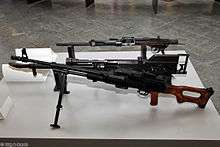
History
The Main Artillery Directorate of the Soviet Union adopted specification requirements for a 7.62 mm general-purpose company- and battalion-level machine gun, chambered for a rifle cartridge in 1955. In 1958 a machine gun prototype, developed by G.I. Nikitin and Yuri M. Sokolov, successfully passed field tests. Based on the results of the tests it was decided in 1960 to manufacture a batch of Nikitin-Sokolov machine guns for service tests and then put the machine gun into production at the Kovrov Mechanical Plant. When the Nikitin-Sokolov machine gun was almost completed, a team of Izhevsk Mechanical Plant designers, headed by M.T. Kalashnikov, and further consisting of V.V. Krupin, V.N. Pushchin, A.D. Kryakushin, as well as Startsev, Kamzolov, Koryakovtsev, Yuferev, joined the competition. Their machine gun prototype was based on the well-proven gas-operated rotary-bolt design of the Kalashnikov-pattern arms.
The Kalashnikov and the Nikitin-Sokolov prototypes underwent service tests in the Central Asian, Odessa, and Baltic Military Districts, as well as at the Vystrel officer training courses in late 1960. The Main Missiles and Artillery Directorate and the Ministry of the Defence Industry preferred the Kalashnikov design. The Kalashnikov design was found to be more reliable and cheaper to manufacture than the design of Grigory Nikitin and Yuri Sokolov.
The PK/PKS was put into production at the Kovrov Mechanical Plant and used the tripod mount and an ammunition belt boxes originally designed for the Nikitin-Sokolov prototype machine gun.
Nikitin's and Sokolov's machine gun design was later used in the 12.7 mm NSV heavy machine gun that was put into production in 1971.
Design details
The original PK was a development of Kalashnikov's AKM assault rifle and the accompanying RPK light machine gun design that featured stamped receivers. The PK uses the 7.62×54mmR Eastern Bloc standard cartridge that produces significantly more bolt thrust when compared to the Eastern Bloc 7.62×39mm and 5.45×39mm intermediate cartridges.
Operating mechanism
The bolt and carrier design are similar to the AK-47 and other modernized Kalashnikov-pattern weapons, as is the stripping procedure performed to remove those mechanisms from the gun for cleaning. The bolt and bolt carrier are however oriented upside down compared to the AKM, with the piston and gas system being underneath the barrel.
Unlike the AKM and RPK the PK machine gun series is an open bolt design, which improves heat management during automatic fire compared to closed bolt designs and helps avoiding the dangerous phenomenon known as "cook-off", wherein the firing chamber becomes so hot that the propellant contained in a chambered round unintentionally ignites, making the weapon fire until the ammunition is exhausted. Open bolt designs typically operate much cooler than closed bolt designs due to the airflow allowed into the chamber, action and barrel during pauses between bursts, making them more suitable for constant full-automatic weapons such as machine guns. General-purpose machine guns like the PK are further normally issued with several quick change barrels that during prolonged intense use are swapped out allowing one barrel to cool while the machine gun fires with the other.
The rimmed 7.62×54mmR cartridges are set in a metal ammunition belt and are held against the shoulder inside non disintegrating looped links, leaving the rim exposed at the rear. The belt is mounted from the right side into the feedway of the PK machine gun. The PK uses a non-reciprocating charging handle on the right side of the receiver to charge the gun. Since the PK uses a rimmed rifle cartridge and closed-link belts used for feeding, a two-stage feed mechanism with a preliminary extraction of a cartridge from a belt link was preferred over a direct ammunition feed design often used for rimmed cartridges. The PK machine gun is equipped with a lever-type feed mechanism, mounted on the feed cover and operated by the feed lever, mounted on the right wall of the receiver and wrapping around the bolt carrier with its feed pawl and roller. The PK feed mechanism pulls the rimmed 7.62×54mmR cartridges out from the back of the ammunition belt and drops the cartridges down into the feed way, allowing the bolt to strip and feed the cartridges into the chamber for firing. The PK feed mechanism is radically different than that of machine guns based on the MG 42 feed mechanism, designed with a much larger (and therefore much heavier) articulated feed cam, lever, and pawl assembly that pushes rimless cartridges out forward from their links directly into the chamber for firing.
The breech is locked by a rotating bolt, with two locking lugs engaging locking recesses in the receiver. The gas piston is hinged to the bolt carrier assembly, and its vertical travel makes it possible to bend the group making machine gun assembly and disassembly for maintenance easier. The protruding rear part of the bolt carrier assembly features spiral shaped cuts, which provide a controlled rotation of the bolt. The mainspring is accommodated in the bolt carrier assembly slide channel. A cartridge extractor with a latch is mounted in the rear part of the bolt carrier assembly. The cocking lever, mounted on the right, is not integral with the bolt carrier and does not reciprocate as the gun fires. The machine gun fires from the rear sear.
The gas cylinder is mounted under the barrel and fitted with a gas regulator with three fixed positions. The gas regulator opens corresponding holes to change the amount of expanding propellant gases bled off out of the gas cylinder into the atmosphere, thus varying the amount of energy transferred on to the long-stroke piston.
Receiver
The PK general-purpose machine gun U-shaped receiver is stamped from a smooth 1.5 mm (0.06 in) sheet of steel that is supported extensively by pins and rivets. For additional rigidity and strength the PK receiver features double walls made from 1.5 mm steel plates that are welded together with the U-shaped stamping. The receiver top cover is also stamped from 1.5 mm sheet metal and hinged on the front of the receiver and locked at the back with a spring-loaded latch.
Barrel
The quick detachable barrel assembly slides into the receiver and attaches by a barrel-lock. On the original PK it was partially fluted to increase rigidity and improve heat dissipation. The barrel-lock also regulates the gap between the breech face and the breech end of the barrel. PK barrels have a folding carry handle/grip that is positioned to the left of the receiver and is used to transport the weapon and quickly and safely change-out barrels to prevent barrel overheating. The bore is chrome-lined and features four right-hand grooves at a 240 mm (1 in 9.45 in) rifling twist rate. The muzzle is threaded for the installation of various muzzle devices such as a flash hider. The muzzle was normally equipped with a conical flash suppressor that added 53 mm (2.1 in) to the barrel and later a long slotted flash suppressor that added 72 mm (2.8 in) to the barrel. Later when the PKM variant was introduced the PK series barrel fluting was omitted and the muzzle device was changed to a shorter cylindrical slotted flash suppressor that added 40 mm (1.6 in) to the barrel. The PKM barrel assembly weighs 2.4 kg (5.3 lb) and can fire up to 400 rounds in rapid fire scenarios before it has to be replaced for another barrel or allowed to cool down to prevent unacceptable wear of the bore.
Sights
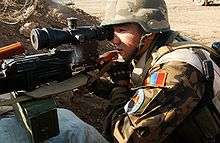
Iron sights
The rear sight assembly is riveted onto the receiver cover and consist of a square notched rear tangent iron sight calibrated in 100 m (109 yd) increments from 100 to 1,500 m (109 to 1,640 yd) and includes a "point-blank range" battle zero setting corresponding to a 330 m (361 yd) zero. It is identical in design to the AKM and Mosin–Nagant, except that it is oriented backwards with the notch forward and the hinge behind. The iron sight line has a 663 mm (26.1 in) sight radius. Like the RPD rear sight, the PK rear sight also features full windage adjustment in the form of small dials on either side of the notch.
The front sight assembly is mounted near the end of the barrel and consists of a protected open post adjustable for elevation in the field.
Optical sights
PK machine guns that feature a Warsaw Pact side-rail bracket on the left side of the receiver can mount various aiming optics. The standard Russian side rail mounted optical sight was the 4×26 1P29 Universal sight for small arms, an aiming optic similar to the British SUIT and SUSAT and Canadian C79 optical sights. When mounted, the 1P29 sight is positioned centered above the receiver at a height that allows the use of the iron sights. It weighs 0.8 kg, offers 4× magnification with a field of view of 8° and 35 mm eye relief. The 1P29 is issued with a canvas pouch, a lens cleaning cloth, combination tool, two rubber eyecups, two eyecup clamps and three different bullet drop compensation (BDC) cams for the AK-74, RPK-74 and PK machine gun. The 1P29 is intended for quickly engaging point and area targets at various ranges. On the right side of the field of view a stadiametric rangefinder is incorporated that can be used to determine the distance from a 1.5 meters (4 ft 11.1 in) tall object from 400 to 1,200 m (437 to 1,312 yd). The reticle is an inverted aiming post in the top half of the field of view and is tritium-illuminated for low-light condition aiming.[17][18][19] A later designed similar optical sight suitable for the PK machine gun series is the 4×24 1Р77[20]
Trigger
The trigger assembly, mounted inside the receiver, is operated by the mainspring and suitable for automatic fire. It has no single shot mode. The manual rotating type safety locks the sear, which engages the sear notch of the bolt carrier assembly, and the trigger lug does not allow the bolt earner assembly to go all the way back.
Stock
The skeletonized buttstock, pistol grip and folding carry handle/grip on the barrels were originally manufactured from birch plywood laminates. Such engineered woods are stronger and resist warping better than the conventional one-piece patterns, do not require lengthy maturing, and are cheaper. The wooden furniture was finished with the Russian amber shellac finishing process. Small accessories and an oil-solvent container can be stored inside butt recesses. Later the buttstock was fitted with a hinged butt-rest. More recent PKM machine guns and barrel assemblies are equipped with a new black glass-filled polyamide buttstock, pistol grip and barrel carry handle/grip shaped like the previously used laminated wooden stock and grips.
Feeding
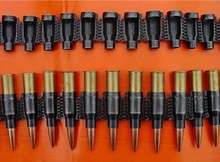
PK machine guns are belt-fed, using non-disintegrating metal belts, which have links that wrap around the cartridge case shoulder all the way around, and are linked by a coiling wire on each side. The links are made of 0.8 mm (0.03 in) thick high carbon stamped steel sheet metal that is zinc phosphated and varnished for protection. These belts are preloaded at ammunition factories in 25-round connectable belt lengths and can be linked to any length necessary. Factory connected PK ammunition belts are available in 25, 100, 200 and 250 rounds lengths. Typical of Soviet machine guns, the PK feeds from the right and ejects its spent cases via an ejection port on the left side of the weapon, contrary to the right side ejection port seen in most Western machine guns.
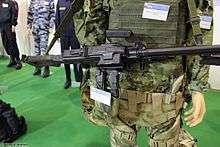
For the light machine gun role, the PK is used as the standard squad automatic weapon of the Russian Army. The PK uses a 100-round non-disintegrating belt contained in a metal box made from an aluminum frame and steel cover that can be attached under the gun's receiver. The 100-round belt "assault" box has a folding lid in its cover for feeding the ammunition belt when the box is attached under the machine gun receiver and weighs 3.9 kg (8.60 lb) or 3.4 kg (7.50 lb) for the modernized all aluminum lightweight variant. When the machine gun is fired from a bipod, the 100-round ammunition box is normally attached to the underside of the receiver.
For the medium machine gun role, there is also a 200/250-round ammunition box made from an aluminum frame and steel cover available which can be mounted on the tripods used for the PK machine gun series. A 200/250-round ammunition box containing a 250-round non-disintegrating belt weighs 9.4 kg (20.72 lb) and containing a 200-round non-disintegrating belt weighs 8 kg (17.64 lb) or 6.2 kg (13.67 lb) for the modernized all aluminum lightweight variant. Both metal ammunition boxes have canvas carry handles.
All openings on the machine gun, particularly the ejector port on the left and the belt feed entrance on the right, are covered with spring-loaded dust covers so that the openings are only exposed when they need to be.
Accessories
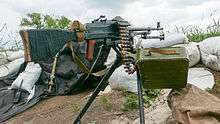
The PK is equipped with a simple detachable bipod mounted to the gas cylinder beneath the barrel and in that setup is used as a squad-level support weapon. The right bipod leg accommodates links of a cleaning rod. Other accessories include a sling and storage covers.
The PK machine gun is also suitable for installation on tripod mounts, vehicle mounting and can also be used as a light anti-aircraft weapon against slow flying aircraft when it is put on an AA mount.
As with all general-purpose machine guns, tripod and vehicle mountings offer a higher degree of accuracy and control than when used on a less stable bipod. The PK machine gun, firing short bursts from a bipod, as a light machine gun has the following accuracy of fire: a mean deviation of 7–10 cm (2.8–3.9 in) at a range of 100 m (109 yd), 37–51 cm (15–20 in) at 500 m (547 yd), and 71–103 cm (28–41 in) at 1,000 m (1,094 yd).[21] The Russian and other European militaries use a circular error probable method that assumes a 50% hit probability (R50) and cannot be converted and is not comparable to US military methods for determining samll arms accuracy. When the R50 results are doubled the hit probability increases to 93.7%.
Variants
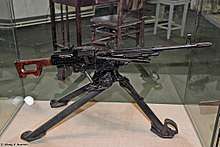
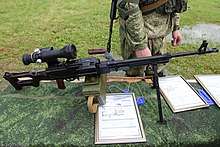
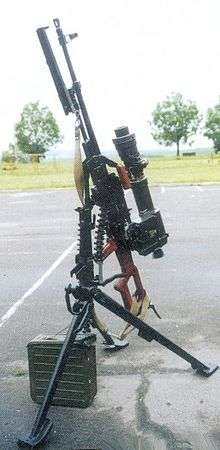


PKS
For heavier employment, the PKS ("PK Mounted") is based on the Samozhenkov 6T2 tripod mount. The PK and 6T2 tripod weigh 16.5 kg (36.38 lb).
The 6T2 Samozhenkov tripod mount was designed by E. S. Samozhenkov and entered service in 1961 and weighs 7.5 kg (16.53 lb). The 6T2 Samozhenkov tripod mount was earlier envisioned for the Nikitin-Sokoiov machine gun that was not adopted by the Soviet Union. All types of ammunition belt boxes are carried and mounted separately. The Rakov device is used for loading ammunition belts. The PK machine gun is attached to a cradle on the 6T2 Samozhenkov mount. The cradle is hinged to a plug-in swivel equipped with a rack-and-pinion traversing mechanism, and a rod-and-screw elevation mechanism. The traversing mechanism is fitted with stops to limit the field of fire. For anti-aircraft fire or fire against ground targets from a kneeling position the cradle mounts a collapsible pole with a pivoting bracket. The mount features non-digging-in spades — sliding spades affect the accuracy of fire less than a "jumping" tripod with dug-in spades. There is an extra folding spade on the front leg for slippery and moving ground. Hinged tripod legs allow a gunner to fire the machine gun from a prone, a sitting, or a kneeling position.
The PKS machine gun, firing bursts from its tripod with fixed traversing and elevation mechanisms, as a medium machine gun has the following accuracy of fire: mean deviation of 5–6 cm (2.0–2.4 in) at a range of 100 m (109 yd), 25–29 cm (9.8–11.4 in) cm at 500 m (547 yd), and 49–68 cm (19–27 in) at 1,000 m (1,094 yd).[21] The Russian and other European militaries use a circular error probable method that assumes a 50% hit probability (R50) and cannot be converted and is not comparable to US military methods for determining samll arms accuracy. When the R50 results are doubled the hit probability increases to 93.7%.
PKM
The PKM (ПК Модернизированный: "Kalashnikov's Machine-gun Modernized"), was adopted into service in 1969. The PKM is a modernized, product-improved version of the PK. The upgrades, primarily aimed at reducing the weight, simplifying production, and facilitating easier operation. The receiver cover became more rigid due to lengthwise ribs. The butt was fitted with a hinged butt-rest. The barrel fluting was omitted and the flash hider was changed. Later on the PKM was equipped with a new black glass-filled polyamide buttstock and pistol grip shaped like the previously used laminated wooden stock and grip.
PKMN
The PKMN (ПКМ Ночной: "PKM Night-Vision") is a variant that can mount a night sight for low-visibility operations. The PKMN-1 can thus mount the multi-model NSPU-3 (1PN51) night vision scope[22] while the PKMN-2 can mount the multi-model NSPUM (1PN58) night vision scope.[23] It can also be fitted with the 1PN93 series[24] passive night sights.
Besides that Shakhin[25] and 1PN116[26] thermal sights and the 1PN119[27] anti-sniper special-purpose night vision sight are available for mounting on PK machine guns that like the PKMN model feature a Warsaw Pact side-rail bracket on the left side of the receiver for mounting aiming optics.
PKMS
For heavier employment, the PKMS (ПКМ Станковый: "PKM Mounted") is mounted on the Stepanov 6T5 tripod mount. The PKM and 6T5 tripod weigh 12 kg (26.46 lb).
The tripod mount, designed by L. V. Stepanov for the PKM machine gun entered service in 1969 and weighs 4.5 kg (9.92 lb). It is a lighter mount for the PK(M) general-purpose machine gun without affecting the accuracy of fire. Besides, the Stepanov mount has 20 fewer components than the preceding Samozhenkov tripod and is 40% less labour-intensive. The Stepanov mount is based on a principle of multi-functional components: the elevation mechanism frame is also used as a pole for kneeled shooting or anti-aircraft fire; the base sleeve also serves as the axis for attaching rear legs of the tripod: the machine gun attachment is combined with the elevation mechanism frame lock for anti-aircraft fire; the fine elevation adjustment mechanism is integrated with the elevation mechanism axis. The ammunition belt box can be secured to the right rear tripod leg. This enables one crew member to carry and operate the gun in combat without having to unload the gun before repositioning the gun.
PKMSN
The PKMSN (ПКМС Ночной: "PKMS Night-Vision") is similarly to the PKMN a special model of the tripod-mounted variant that can mount night sights for low-visibility operations.
The PKMSN model can use NSPU-3 (1PN51)[22] and NSPUM (1PN58) night sights.[23] It can also be fitted with the 1PN93 series[24] passive night sights.
Besides that Shakhin[25] and 1PN116[26] thermal sights and the 1PN119[27] anti-sniper special-purpose night vision sight are available for mounting on PK machine guns that like the PKMSN model feature a Warsaw Pact side-rail bracket on the left side of the receiver for mounting aiming optics.
PKT
The PKT (ПК Танковый, "PK Tank") (1968) is a solenoid-fired coaxial version of PK to replace the SGMT Goryunov vehicle-mounted machine gun. Modifications include the removal of the stock, a longer and heavier barrel, a gas regulator and an electric solenoid trigger. The PKT is usually fed from 250-round ammunition boxes. The PKT barrel assembly weighs 3.23 kg (7.1 lb) and can fire up to 500 rounds in rapid fire scenarios before it has to be replaced for another barrel or allowed to cool down to prevent unacceptable wear of the bore.
Its ballistic performance with various ammunition types is stated as:[28]
| Cartridge designation[29][30] |
57-N-323S | 7N13 (AP) | 7T2 (tracer) | 7BZ3 (API) |
|---|---|---|---|---|
| Cartridge weight | 21.8 g (336 gr) | 21.7 g (335 gr) | 22 g (340 gr) | 22.6 g (349 gr) |
| Bullet weight | 9.6 g (148.2 gr) | 9.4 g (145.1 gr) | 9.65 g (148.9 gr) | 10.39 g (160.3 gr) |
| Muzzle velocity | 855 m/s (2,805 ft/s) | 855 m/s (2,805 ft/s) | 824 m/s (2,703 ft/s) | 834 m/s (2,736 ft/s) |
| Muzzle energy | 3,509 J (2,588 ft⋅lbf) | 3,436 J (2,534 ft⋅lbf) | 3,276 J (2,416 ft⋅lbf) | 3,613 J (2,665 ft⋅lbf) |
| Accuracy of fire at 300 m (328 yd) |
90 mm (3.5 in) (R50) | 90 mm (3.5 in) (R50) | 150 mm (5.9 in) (R50) | 150 mm (5.9 in) (R50) |
- R50 at 300 m (328 yd) means the closest 50% of the shot group will all be within a circle of the mentioned diameter at 300 m (328 yd).
PKMT
Modernized version of PKT.[31]
PKB
Version on which a set of spade grips replace the stock, for mounting on roofs of vehicles.[32]
PKBM
Modernized version of PKB.
PKP Pecheneg
- The PKP Pecheneg (6P41) (2001) is a further development and modification of the PKM. It has a heavy fixed barrel encased in a radial cooling sleeve that uses forced-air cooling, much like the Lewis Gun of World War I.
- 6P41N Pecheneg-NP version with a rail for mounting nightscopes.
- Pecheneg-SP improved modernized version.
Foreign variants
HCP PKM-"NATO" (Poland)
In the early 1990s, as part of the preparations to join NATO, the Polish armed forces were looking for a replacement for the PK-series machine guns then in service. The H. Cegielski - Poznań S.A. Works in Poznań modified the PK/PKS to feed standard 7.62×51mm NATO cartridges and use NATO standard ammunition belts. The new model received the code-name PKM-NATO. The modifications included a heavier barrel, a larger chamber, and a redesign of the lock, extractor, and the entire feeding mechanism. The prototype was tested from 1997 to 1999, but was rejected. The Polish Army adopted the UKM-2000 machine gun instead – which was also based on the PKM.
Zastava M84/M86/M09/M10 (Yugoslavia/Serbia)
The Zastava M84 is a Yugoslav/Serbian-made licensed copy of the PK/PKS. The Zastava M86 is a copy of the solenoid-triggered PKT. These variants can be easily recognised by their unhollowed stock.
The Zastava M09 is a copy of the PKM with black synthetic furniture, chambered in 5.56x45 NATO ammo. The Zastava M10 is a variant of the M09 with a solid stock.
Norinco Type 80 (People's Republic of China)
The Type 80 is a Chinese-made copy of the PKM/PKMS.
Arsenal MG, MG-M1, MG-M1S & MG-1M (Bulgaria)
Arsenal originally produced the MG, modeled after the original Russian PK model. The MG-M1 is a licensed copy of the PKM with a synthetic buttstock and pistol grip. The MG-M1S only differs from the MG-M1 model due to the use of a tripod by the M1S model, where as the M1 model uses the original bi-pod design.[33] The MG-1M, an improved Squad Automatic Weapon variant, has improved features, such as a redesigned barrel that allows for better cooling.[34]
Cugir Mitraliera md. 66 (Romania)
The Mitraliera md. 66 is a Romanian-made copy of the PKM.
KGK general purpose machine gun (Hungary)
The KGK universal (general purpose) machine gun was based on the SG43 Goryunov machinegun and produced in Hungary during the 1960s and 1970s. It was used by the Hungarian army on a limited scale and was later replaced by a domestically produced copy of the Kalashnikov PKM machine gun.
Production status
The PKM and other variants are in production in Russia and are currently exported to many nations. Additionally, various models are manufactured locally around the globe. Zastava Arms produces the PK under license as the M84 (along with the PKT as the M86), and it remains in use with many of the former Yugoslav successor states. The most recent modification is the Russian Pecheneg, which features a forced air cooling barrel that cannot be removed in the field for quick replacement, unusual for a modern machine gun.
Users
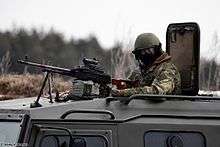
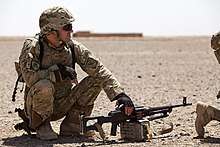
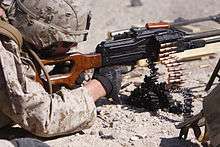
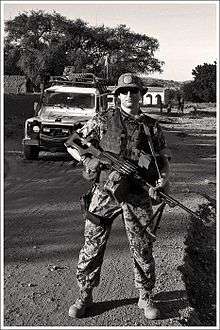
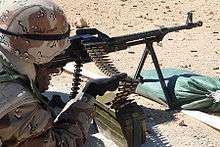










































































- Jowhar government of Mohamed Dheere[50]








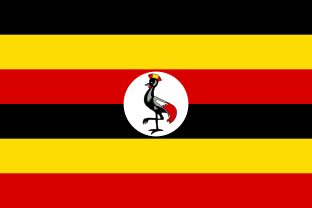






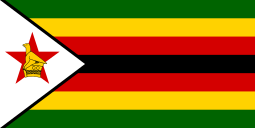
Former users


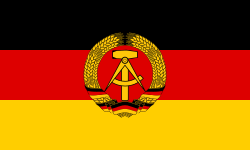



.svg.png)

See also
- PKP "Pecheneg"
Notes
- Campbell, David (30 Nov 2017). Soviet Paratrooper vs Mujahideen Fighter: Afghanistan 1979–89. Combat 29. Osprey Publishing. pp. 42, 66–68. ISBN 9781472817648.
- Small Arms Survey (2006). "Fuelling Fear: The Lord's Resistance Army and Small Arms" (PDF). Small Arms Survey 2006: Unfinished Business. Oxford University Press. p. 283. ISBN 978-0-19-929848-8. Archived from the original on 2018-08-30. Retrieved 2018-08-29.
- Small Arms Survey (2005). "Sourcing the Tools of War: Small Arms Supplies to Conflict Zones" (PDF). Small Arms Survey 2005: Weapons at War. Oxford University Press. p. 166. ISBN 978-0-19-928085-8. Archived from the original on 2018-08-30. Retrieved 2018-08-29.
- "theage.com.au - The Age". www.theage.com.au. Archived from the original on 2017-03-05. Retrieved 2016-11-25.
- "Syrie: l'EI inflige un revers aux FDS dans l'est, mais reste acculé". France Soir (in French). 25 October 2018. Archived from the original on 25 October 2018. Retrieved 26 October 2018.
- Ruptly (12 August 2016). "Yemen: Government forces battle Houthis in Taiz after peace talks break down". Archived from the original on 18 August 2017. Retrieved 26 April 2017 – via YouTube.
- Yemen War 2015 - Heavy Clashes On The Saudi Border As Houthi Rebels Attack Saudi Military Outposts (in Arabic). Yemen. 2015. Event occurs at 6:14. Archived from the original on 12 August 2015. Retrieved 19 June 2015.
- "YouTube". www.youtube.com.
- "Open Joint Stock Company 'V.A.Degtyarev Plant' / 7.62mm PKTM Kalashnikov tank machine gun". www.zid.ru. Archived from the original on 2015-03-15. Retrieved 2015-03-15.
- "Open Joint Stock Company 'V.A.Degtyarev Plant' / 7.62mm PKMS Kalashnikov modernized machine gun on a Stepanov mount". www.zid.ru. Archived from the original on 2015-03-15. Retrieved 2015-03-15.
- "Open Joint Stock Company 'V.A.Degtyarev Plant' / 7.62mm PKM Kalashnikov modernized machine gun". www.zid.ru. Archived from the original on 2015-03-15. Retrieved 2015-03-15.
- "Open Joint Stock Company 'V.A.Degtyarev Plant' / 7.62mm PKMB Kalashnikov machine gun (APC version)". www.zid.ru. Archived from the original on 2015-03-15. Retrieved 2015-03-15.
- https://fas.org/man/dod-101/sys/land/row/weg2001.pdf Archived 2015-04-25 at the Wayback Machine OPFOR Worldwide Equipment Guide, Sep 2001, DEPARTMENT OF THE ARMY, TRADOC DCSINT, Threat Support Directorate, 700 Scott Avenue, Bldg 53, FORT LEAVENWORTH, KS, 66027-1323, page 1-5
- "Sights". Russian Close Combat Weapon. Moscow: Association "Defense Enterprises Assistance League". 2010. ISBN 978-5-904540-04-3.
- Lawrence, Erik (13 March 2015). Practical Guide to the Operational Use of the PK/PKM Machine Gun. Erik Lawrence Publications. ISBN 9781941998212. Archived from the original on 5 October 2018. Retrieved 22 September 2017 – via Google Books.
- "7.62mm PKM Kalashnikov modernized machine gun". Archived from the original on 5 November 2014. Retrieved 13 November 2014.
- 1P29 4.0x Magnification Archived 2013-12-04 at the Wayback Machine. Russianoptics.net
- "1P29 Universal sight for small arms NPZ Novosibirsk Instrument-Making Plant". Archived from the original on 29 November 2014. Retrieved 16 November 2014.
- "Image collection of 1P29 sights". Archived from the original on 29 November 2014. Retrieved 16 November 2014.
- "1Р77 Gunsight". gunrf.ru. Archived from the original on 2015-10-21. Retrieved 2015-09-21.
- "PK/PKS Kalashnikov". gunrf.ru. Archived from the original on 2015-09-27. Retrieved 2015-09-18.
- ИЗДЕЛИЕ 1ПН51 ТЕХНИЧЕСКОЕ ОПИСАНИЕ И ИНСТРУКЦИЯ ПО ЭКСПЛУАТАЦИИ [PRODUCT 1PN51 TECHNICAL DESCRIPTION AND OPERATING INSTRUCTIONS] (in Russian). January 1992. pp. 11, 16.
- ИЗДЕЛИЕ 1ПН58 ТЕХНИЧЕСКОЕ ОПИСАНИЕ И ИНСТРУКЦИЯ ПО ЭКСПЛУАТАЦИИ [PRODUCT 1PN58 TECHNICAL DESCRIPTION AND OPERATING INSTRUCTIONS] (in Russian). February 1991. pp. 5, 13.
- "1PN93 Magnus Night Wssion Sights". gunrf.ru. Archived from the original on 2015-09-26. Retrieved 2015-09-21.
- "Shakhin Thermal Sights". gunrf.ru. Archived from the original on 2015-09-26. Retrieved 2015-09-21.
- "1PN116 Thermal Sights". gunrf.ru. Archived from the original on 2015-09-26. Retrieved 2015-09-21.
- "Anti-Sniper Special Purpose Night Vision Sights". gunrf.ru. Archived from the original on 2015-09-26. Retrieved 2015-09-21.
- Creations, (c) 2000-2002 Vasiliy Fofanov - Sauron's. "PKT 7.62mm Coax MG". fofanov.armor.kiev.ua. Archived from the original on 2015-07-02. Retrieved 2015-09-26.
- "Russian 7.62x54mm Rounds for Rifles and Machine Guns, Land Forces Weapons Export Catalog, page 87" (PDF). Archived from the original (PDF) on 2011-12-16.
- "LVE Novosibirsk Cartridge Plant: 7,62mm rifle cartridge with steel core bullet". www.lveplant.ru. Archived from the original on 2015-11-07. Retrieved 2015-09-26.
- "PKMT". gunrf.ru. Archived from the original on 2015-08-08. Retrieved 2015-09-18.
- Bonds, Ray; Miller, David (13 February 2003). Illustrated Directory of Special Forces. Voyageur Press. ISBN 9780760314197. Archived from the original on 1 December 2017. Retrieved 17 November 2017 – via Google Books.
- Creamer, CPT Shawn (2005). "Operator's Manual: PK-Series General-Purpose Machinegun" (PDF). Department of the Army, National Ground Intelligence Center. Archived (PDF) from the original on March 10, 2016. Retrieved October 1, 2015.
- "Arsenal 7.62mm "ARSENAL" Machine Gun MG -1M". www.arsenal-bg.com. Archived from the original on 2015-09-23. Retrieved 2015-10-01.
- User, Super. "Small arms - ПАТ "Завод Маяк" - Українська зброя". www.mayak.com.ua. Archived from the original on 2016-11-19. Retrieved 2016-11-19.
- "Arms & Security 2011". Small Arms Defense Journal. Archived from the original on 2016-11-19. Retrieved 2016-11-19.
- User, Super. "Tank machine gun KT-7,62 - ПАТ "Завод Маяк" - Українська зброя". www.mayak.com.ua. Archived from the original on 2016-10-25. Retrieved 2016-11-19.
- Jones, Richard D. Jane's Infantry Weapons 2009/2010. Jane's Information Group; 35 edition (January 27, 2009). ISBN 978-0-7106-2869-5.
- "World Infantry Weapons: Algeria". 2015. Archived from the original on 24 November 2016. Retrieved 17 July 2020.
- "President Guard Regiment". Archived from the original on 2013-04-28. Retrieved 2013-04-29.
- "UNROCA original report Bangladesh 2007". Retrieved 23 July 2020.
- "G3 Defence Magazine August 2010". calameo.com. Archived from the original on 25 March 2012. Retrieved 13 November 2014.
- Small Arms Survey (2007). "Armed Violence in Burundi: Conflict and Post-Conflict Bujumbura" (PDF). The Small Arms Survey 2007: Guns and the City. Cambridge University Press. p. 204. ISBN 978-0-521-88039-8. Archived from the original on 2018-08-27. Retrieved 2018-08-29.
- "Small Arms Survey - Working Papers" (PDF). 8 November 2012. Archived (PDF) from the original on 4 July 2010. Retrieved 13 November 2014.
- Letter dated 26 June 2014 from the Panel of Experts on the Central African Republic established pursuant to Security Council resolution 2127 (2013) addressed to the President of the Security Council (PDF). 1 July 2014. p. 81. Archived (PDF) from the original on 29 March 2017. Retrieved 30 January 2019.
- McGregor, Andrew (May 15, 2018). "How Russia Is Displacing the French in the Struggle for Influence in the Central African Republic". Eurasia Daily Monitor. Jamestown Foundation. 15 (74). Archived from the original on August 2, 2018. Retrieved September 26, 2018.
- Type 80 7.62mm General Purpose Machine Gun. Retrieved on September 11, 2008.
- Mikulka, Zdeněk (19 February 2010). "Střelby z palubních zbraní vrtulníků Mi-171Š v Afghánistánu". Zahraniční mise. Ministerstvo obrany. Archived from the original on 22 September 2013. Retrieved 16 May 2013.
- Small Arms Survey (2015). "Waning Cohesion: The Rise and Fall of the FDLR–FOCA" (PDF). Small Arms Survey 2015: weapons and the world (PDF). Cambridge University Press. p. 202. Archived (PDF) from the original on 2018-01-28. Retrieved 2018-08-29.
- Small Arms Survey (2007). "Probing the Grey Area: Irresponsible Small Arms Transfers" (PDF). The Small Arms Survey 2007: Guns and the City. Cambridge University Press. p. 93. ISBN 978-0-521-88039-8. Archived from the original on 2018-08-27. Retrieved 2018-08-29.
- "Rosyjska broń dla Fidżi" (in Polish). altair.pl. Archived from the original on 2016-03-04. Retrieved 2016-02-21.
- "Konekivääri 7.62 KK PKM". maavoimat.fi. Archived from the original on 15 December 2017. Retrieved 15 December 2017.
- Matt Cetti-Roberts (2015-10-26). "To the Edge of Kurdistan Volunteer peshmerga prepare for a major assault near Kirkuk". War is Boring. Archived from the original on 2017-07-28. Retrieved 2017-07-04.
- "Syrie: l'EI inflige un revers aux FDS dans l'est, mais reste acculé". France Soir (in French). 25 October 2018. Archived from the original on 25 October 2018. Retrieved 26 October 2018.
- "מתנות מהאויב: ההיסטוריה המפותלת של נשק השלל". Mako. 27 April 2016. Archived from the original on 5 February 2018. Retrieved 28 November 2017.
- de Tessières, Savannah (April 2012). Enquête nationale sur les armes légères et de petit calibre en Côte d'Ivoire: les défis du contrôle des armes et de la lutte contre la violence armée avant la crise post-électorale (PDF) (Report). Special Report No. 14 (in French). UNDP, Commission Nationale de Lutte contre la Prolifération et la Circulation Illicite des Armes Légères et de Petit Calibre and Small Arms Survey. p. 97. Archived (PDF) from the original on 2018-10-09. Retrieved 2018-08-30.CS1 maint: ref=harv (link)
- Jenzen-Jones, N.R.; McCollum, Ian (April 2017). Small Arms Survey (ed.). Web Trafficking: Analysing the Online Trade of Small Arms and Light Weapons in Libya (PDF). Working Paper No. 26. p. 33. Archived (PDF) from the original on 2018-10-09. Retrieved 2018-08-30.CS1 maint: ref=harv (link)
- "North Korean Small Arms". Small Arms Defense Journal. Archived from the original on 2016-08-27. Retrieved 2016-11-21.
- Cooper, Tom (2013). Great Lakes Conflagration: Second Congo War, 1998 2003. UK: Helion & Company Limited. p. 20. ISBN 978-1-920143-84-8.CS1 maint: ref=harv (link)
- "World Infantry Weapons: Sierra Leone". 2013. Archived from the original on 24 November 2016.
- Savannah de Tessières (January 2018). At the Crossroads of Sahelian Conflicts: Insecurity, Terrorism, and Arms Trafficking in Niger (PDF) (Report). Small Arms Survey. p. 53. ISBN 978-2-940548-48-4. Archived (PDF) from the original on 2018-06-12. Retrieved 2018-06-05.
- "Chinese arms, radar for Sri Lanka military". 2007-06-05. Archived from the original on 2012-06-14. Retrieved 2010-05-04.
- "SLAHLAR". Archived from the original on 14 December 2014. Retrieved 13 November 2014.
- "MKEK's 7.62mm PKM and MAG designs, Production Ready? - The Firearm Blog". 13 October 2017. Archived from the original on 23 October 2017. Retrieved 22 October 2017.
- UaPositon (18 May 2016). "Defense Ministry introduces new Ukrainian-made light machine gun". Archived from the original on 19 November 2016. Retrieved 19 November 2016.
- "NVA". Archived from the original on 30 January 2013. Retrieved 13 November 2014.
- VCCorp.vn. "Việt Nam sản xuất thành công súng máy PKMS hiện đại". Archived from the original on 2016-11-07. Retrieved 2016-11-06.
- Cooper 2013, p. 36.
External links
| Wikimedia Commons has media related to PK machine gun. |
- Original producer website
- Modern Firearms
- Modern Firearms—Pecheneg
- http://www.kalashnikov.ru/upload/medialibrary/637/nazvalsya-gruzdem.pdf
- http://www.kalashnikov.ru/upload/medialibrary/32b/ot-PK-kPKM.pdf
- Technical data, instructional images and diagrams of the PK machine gun (in Russian)
- Video of operation on YouTube
- 7.62 mm Kalashnikov РК / PKS machine gun
- PKM/PKMS Kalashnikov modernized machine gun
- PKMT Kalashnikov modernized tank machine gun
- PKMB Kalashnikov modernized armored personnel carrier machine gun
- «Pecheneg» Kalashnikov infantry machine gun